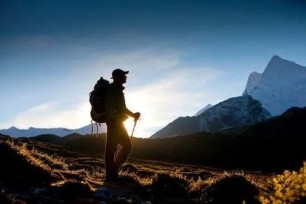General Insurance Blogs, Articles & Updates by - Magma HDI
Have us call you
- RENEW YOUR POLICY
- BUY NEW POLICY

A middle-class life on a two-wheeler: Common mistakes to avoid
Transport is the lifeline of civilization, and the role of low-cost transportation in a developing country like India is crucial. For a larger section of society in urban, semi-urban and rural areas, cars are non-affordable. Therefore, two-wheelers are an all-time favourite among the middle class who can afford something more sophisticated than a bicycle.
While two-wheelers are necessary for many, poor road conditions, unorganized and rash driving, and traffic rules violations make bikers unsafe. Therefore, it is always important to stay safe on the road, ride with proper safety gear and always wear a helmet. To get additional protection for your two-wheeler, you can purchase 2 wheeler insurance online. Insurance can be of great help to overcome the losses due to mistakes that happen on the roads.
Let's have a look at a few common mistakes to avoid while riding a two-wheeler.
1. Listening to music:
Nowadays, many helmets come equipped with a Bluetooth system, with which you can attend calls. They can also communicate with other riders during a group ride, but many people misuse this feature by listening to music through Bluetooth. Music can be distracting to severe extents. It reduces your alertness, and you compromise with your listening ability too. It is always important to have situational attentiveness when in traffic. You can listen to music on a long trip, but that too on a low volume. Be sure that you are still able to hear the faint noises of other approaching vehicles.
2. Travelling at night:
People try to cover long distances at night to avoid the harsh sun during the day, but it can be hazardous. Riding at night is way more challenging than riding in broad daylight. Naturally, the human biological clock winds down at night, thus, making you feel sleepy. So, if you are not a professional rider, it is highly unsafe for you to ride long distances at night. Try to start early in the morning and ride till midday to cover long distances instead of riding at night.
3. Carrying heavy loads:
People have a habit of using their scooters to transport goods for a short distance which can be dangerous. Not only does it deteriorate the performance of the vehicle in the long run, but also affects the braking mechanism. Riding with more than the gross axle weight compromises the vehicle's ability to stop under panic braking situations. So be sure to check out your vehicle's gross axle weight (GAW) on the manufacturing company's website.
4. Overtaking at a blind curve:
At the blind curves on the road, you can only see a few meters in front of you. In such situations, it is risky to overtake the vehicle ahead of you because you may be unaware of any vehicle approaching from the blind side of the curve.
We all have come across at least one person who has met with an accident while riding a bike. Two-wheelers are convenient and cost-effective, but they are also more prone to accidents. So, be doubly sure to have a valid insurance cover, and if you don't have one, we suggest buying a 2 wheeler insurance online. It will financially back you in case of an accident. Be cautious while riding to have safer journeys!
Planning to buy 2 wheeler insurance online? Click HERE for details.
Disclaimer: The information provided above is for illustrative purposes only. To get more details, please refer to policy wordings and prospectus before purchasing a policy.

Constructing your dream house? Make these suggestions a part of your strategy
It is our lifelong emotional dream to have a home for us. It is where we make the most memories with our families and cherish them for the rest of our lives. So, have you already decided to build your house? Congratulations to you on your decision!
But you can't imagine a piece of land as your home as it requires a lot of planning and proper construction. It is advisable to hire professionals as you will spend your life savings on this one project. In this article, we have put together some suggestions to help you design and construct your house.
1. Decide your budget:
The crucial aspect of constructing your own house is the budget. Your budget should be precise and inclusive of the expenses involved, from laying the bricks to finally stepping into your newly constructed home after completion. Remember, after building your house, you should have enough money to support a comfortable living for your family.
2. List the space requirements:
Have an idea of how many bedrooms you wish to have. What should be the appropriate size of your living room and kitchen? Will you need a separate kid's play area or a pooja room? Listing all the requirements will make the design work hassle-free, and the blueprint of your house can be accordingly finalized.
3. Hire an architect:
Find a good architect by looking at some of the portfolios online to better understand their expertise and intent. Then, make sure that the architect offers you the best suggestions for your house. An architect will,
• Make a few designs for you to select from.
• Supervise construction periodically.
• Check and certify the contractor's bills.
• Prepare structural design, Bill of Quantities (BOQ), cost estimates, drawings for approval to the authority, a tender document with T and Cs.
Always sign a formal contract with the architect specifying responsibilities and payment of the architect and associates.
4. Concept Phase:
Finalize the architectural design and appoint an interior designer if necessary. Based on the designer and finishing, you can get a better idea of the final budget.
5. Detailed design:
The structural engineers and electrical consultants will develop the designs and details based on architectural drawings. So it becomes convenient for these people to arrange for the materials and manage the required manpower. A detailed design also helps decisions regarding the flooring materials, ceramic fixtures, CP, fittings, requirements of light points, internet, ceiling fans, etc.
6. Approval from the authorities:
It is essential to obtain prior approval and sanctions for the drawings prepared by the architect. Make sufficient copies of the drawings as these will be required to get power, water, and sewage connections.
7. Tender phase:
The architect prepares a tender document to get the best prices and shares it with a few contractors. Then, you can meet the contractors to negotiate further and discuss essential points like the date of commencement and completion, terms of payment, any additional requirements, etc.
Once the construction phase gets over, the finishing stage commences. Now, collect all the documents related to the project, such as architectural, structural, and services drawings, warranties, final bills, and other necessary documents.
It feels incredible when you see the steel bars, layers of bricks glued with cement taking the shape of your house. You will feel accomplished by observing your progress because just thinking of building a house is itself a bold decision, and successfully making it is even bolder!
There is much discussion on how to construct your house, but what once it is ready? How will you ensure its security? For this, you can go on the web and search for a 'general insurance online quote' and buy the most suitable home insurance to secure your priceless possession financially.
Planning to buy a new home? Click HERE to check out a home insurance plan suitable for you.
Disclaimer: The information provided above is for illustrative purposes only. To get more details, please refer to policy wordings and prospectus before purchasing a policy.

The most common driving errors you don't know you're making
When you start driving, you don't become an expert overnight. For any perfect driver, it takes a good amount of practice every day. Also, for error-free driving, it is necessary to identify and rectify the common driving mistakes. The statistic shows that nearly 98% of the road accidents result from human errors and sheer unawareness. Here are some of the common driving errors that you might be doing ignorantly.
1. Distracted driving:
Most road accidents happen because of our distracted driving. So what are the most common reasons for distraction? Usage of mobile phones while driving tops the list. We feel an urgency to read the message or answer the call immediately that we can't resist it even while driving. But in reality, it's not always the case. We forget the fine line between urgency and emergency and end up committing this small error that can land us in massive trouble while driving.
2. Sitting position and driving posture:
Sometimes your driving pattern harms your body. Getting comfortable in your car with the correct sitting position is necessary. It might affect your back and spine. In addition, your posture can compromise your control over your vehicle, such as pushing the brakes and clutch, which can cause you some trouble.
3. Disobeying/ignoring signal lights:
Now, without getting caught by traffic police, the advancement of CCTV over the roads will burn your pockets when you break the signal. But, we still end up making those silly mistakes like ignoring the yellow/amber signal light. Yellow/amber signal lights are an indicator to "slow down", and when it turns red, you are supposed to "stop". But we prefer to "speed up" so that we don't need to stop and wait at a red light. And that's where most of the car crashing occurs.
4. Unused mirrors/indicators of your vehicle:
The rear-view and side mirrors of your car have some purpose. These mirrors are used to look for the vehicles behind you and on either side of your car.
5. Light indicators while driving:
Lights installed on your vehicle play a vital role in safety. Unfortunately, many of us don't use indicators. It can be unfortunate for you and the vehicles following your car on curvy roads or turnings. It is a good practice to use indicators so that vehicles behind you can be alert and slow down without hitting your car.
Driving with a high beam at night is prone to disaster; it is useful when driving on streets or roads without streetlights. However, it can distract and even blind the other drivers on a two-way road especially.
6. Switching lanes at turns:
Driving and switching lanes is equally dangerous. Start early, if you anticipate some traffic, so that you don't have to indulge in rash driving and over-speeding. Know that life is much more important than the destination you want to reach.
On a conclusive note, we must hold ourselves responsible for ensuring safety on roads. Therefore, practice safe driving and purchase car insurance for more safety of your car and yourself. And timely car insurance renewal is equally necessary for extended protection of your valuable possession.
Are you looking for a renewal of car insurance? Click HERE.
Disclaimer: The information provided above is for illustrative purposes only. To get more details, please refer to policy wordings and prospectus before purchasing a policy.

Visit these best places to enjoy thrilling river rafting experience in India
Considering the multitude of experiences, travellers all across the globe talk about India being their preferred destination for travel. Blessed with an extensive network of rivers flowing through the interiors of different states, India opens up to exciting river adventures for travel enthusiasts. One such adventure is river rafting, which charges up travellers' adrenaline.
This off-beat experience was introduced to boost India's inbound and domestic tourism, and over the years, it has shown remarkable responses from travellers. Manoeuvering the raft, feeling the roaring waters gushing past, and trusting the fellow rafters is a lifetime experience. Following is the list of places where you can plan to enjoy river rafting.
1. The Ganges, Rishikesh:
Rishikesh is a traveller’s favourite river rafting destination in India. Rafting in Ganga promises you a vast arena of difficulty levels and routes. No matter the level of expertise, you get to experience river rafting for everyone here.
Another benefit of choosing this stretch is the breathtaking views. The Garhwal mountains and the white sand river beaches are some of the most beautiful sites you wouldn’t want to miss out on. Plan to visit this place between September and June.
2. Barapole, Coorg:
This river in the southern part of Karnataka circles the Deccan Plateau and is one of the best river rafting fronts in South India. However, the route here is not for the faint-hearted as it is incredibly challenging and covers a stretch of about one hundred and fifty kilometres. July to September is the best time to visit Coorg.
3. Spiti, Himachal:
This stretch of one hundred and eighty kilometres spans between the Tuting region and reaches up to Pasighat. Rafting is spread over six days. What makes it worth the experience is the scenic views of villages and a closer look at the local life of the area. Tourists throng the place during July and August.
4. Kundalika, Maharashtra:
Kundalika is considered to be one of the fastest flowing rivers. River rafting here is open throughout the year. Kundalika is close to Pune and Mumbai, making it ideal for weekend getaways with family and friends. The green views and the rich rice fields are sure to be an experience and worth remembering.
5. Beas, Kullu Manali:
A relatively short route between Pirdi and Jhiri, the river rafting here covers a distance of about 14 kilometres. However, the rapids here can be challenging to manoeuver, but the scenery of the Beas makes it a must-visit place when in Kullu. The rafting is open between July and September.
6. Indus, Ladakh:
Indus hosts many river rafting spots, all of which are open for beginners. It offers spectacular courses and locations such as the Grand Canyon of Asia or the Zanskar canyon, the beautiful Ladakh skies, etc. The best season starts from July and goes on up to September.
Now that you have seen the list of places that host spectacular river rafting experiences in the country, get ready to plan your next trip to these places to feel the thrill. Whether going with family or friends or travelling solo, always keep safety your priority. Follow all the instructions carefully and make the optimum use of the safety gears provided to you. A little negligence can be fatal, and don't let carelessness spoil all your fun.
Take that extra mile towards safety and look for general insurance online quote to add value to your trips. Stay protected against all the additional costs you might face during your journey and are compensated for any damage or loss to your luggage. Ensure a safe touring experience with Magma HDI's insurance coverage.
Click HERE to know more about general insurance online quote.
Disclaimer: The information provided above is for illustrative purposes only. To get more details, please refer to policy wordings and prospectus before purchasing a policy.

Sculpt the perfect body in 25 minutes a day at home
The concept of "no time" gradually becomes an excuse for most urban populations not to exercise at all. The long working hours and corporate lifestyle has made life more stressful than before. The hectic schedules leave little or no time for us to go to the gym for workouts.
Remove the idea that hitting the gym is the only way to have a good physique and a healthy life. Instead, take out just 25 minutes from your daily schedule to do some easy workout exercises to fit.
Here is an exercise plan for you that you can practice without the need for any extra weight other than your body weight.
Warm-Up Exercises
Warm-up is crucial before starting any exercise or physical activity to avoid the possibility of serious injuries. You may include the following exercise in your warm-up routine;
• On spot jog
• On spot jumps
• Knee to chest stretch
• Heel to butt stretch
• Side bends (both sides)
• Forward bend
• Arm and wrist circling
After a good warm-up, it's time to go all-in.
1. Chin-ups (Trains your back and arm strength) –
Directions: You can either purchase a chin-up bar or simply use a structure or a solid beam in your home for doing chin-ups. Place your arms at shoulder width on the bar to get a proper grip for performing the exercise. Hold yourselves at the upward position for 30 seconds, and then gently lower yourself. You've just finished one rep; buckle up for the next!
2. Squats (Trains your Hamstrings, Quadriceps, Glutes):
Directions: Keep your feet hip-width apart, and all of your hips, knees, and toes should be pointing forward. Bend your knees and stretch your buttocks outward as if you were preparing to sit on a chair. Make sure your knees are not crossing your toes, and your weight is on your heels. Rise and repeat the process by maintaining the proper posture and focusing on your breathing.
3. Push-ups (Trains your Triceps, Pectoral muscles, Shoulders):
Directions: Push-ups are the most effective exercise in a workout segment. To do a push-up, get down on your arms and legs, position your hands slightly wider than your shoulders. Then, straighten your arms and legs and go down till the point where your chest touches the floor.
You should feel that tightness in your triceps, chest, and shoulders. But, it is important to manage your breathing pattern during a push-up. When going down, take a deep breath, and release it when coming back up.
Complete as many repetitions as possible in 45 seconds for each exercise. Once time is up, take a 1-2 minutes break before starting round 2. Then, complete a couple of rounds of the whole set, and don't forget to stretch nicely after a good workout session.
To sum it up, practice these home exercises and encourage your family members to do them for at least 25 minutes a day. The results will be slow, but they’ll be evident. Also, we suggest you have a health insurance plan that serves as additional protection and a safety net for you and your family.
Click HERE to know about the best health insurance plans.
Disclaimer: The information provided above is for illustrative purposes only. To get more details, please refer to policy wordings and prospectus before purchasing a policy.

Are you aiming to take basketball as your sport? Here is the guide for you
Basketball is a lesser-talked-about sport in India, but it has seen an increasing number of people investing time in it. The enthusiasm of spectators is overwhelming, making this sport popular. Basketball can be one of the most physically demanding activities. If you are looking to start investing your time to this sport, this article will help you figure out the dos and don'ts of basketball.
1. Buying good shoes:
This is a no-brainer as any sport you play would require you to buy a pair of good shoes. Wearing the wrong size or one with no cushioning can lead to various injuries to the ankle. Buy shoes with proper cushioning and good ankle support while also keeping in mind the shoe's weight. Appropriate shoes are important for basketball players to obtain the optimum leg movement and lift to score baskets.
2. Warm-up:
A good game of basketball can be highly straining and exhausting. Warming up is an excellent way to prepare your muscles and joints for intense physical actions. It also helps reduce the chances of injuries and decreases the efficiency of various body parts. Jogging, jumping jacks, and skipping are some of the best warm-up exercises to prepare you for basketball.
3. Shooting practice:
Basketball is all about getting the ball in the hoop. Shooting from various positions and angles will help you understand the distance and the power you need to throw the ball. Understanding your shooting ranges is vital to ensure you perform well under pressure situations. Start shooting practice within the three-point line and work your way outwards to the half-court.
4. Dribbling:
One common mistake that beginners make is dribbling with their dominant hand. It is important to have command over the ball with both your hands. This is to ensure that in case you are up against a player from the opposing team, you are capable of making a switch between your hands without having to let go of the ball.
During the warm-up, one way to practice this is to try to dribble along the course of your jogging track. Dribble using your dominant hand using the first lap, switch to the non-dominant hand in the next lap and keep switching between the hands in the third lap. Repeating this cycle will ensure a good command over the ball.
5. Jumping:
Be it to defend the ball, collect rebounds, or make a go for the loop, jumping can not be ignored. Various jumping activities such as vertical jump training, jumping jacks, burpees, linear jumps, and rebounding are good ways to ensure flexibility and firm footing. At the same time, stretches effectively increase the height and the general mobility of the entire body.
6. Correct coaching:
Basketball is a team sport and taking note of how your fellow players perform and understanding their skills is vital if you want to improve your techniques. Another benefit of training alongside players is developing a good instinct for the game. It will give you a better insight into the body movements of other players, thus helping you in analysing and predicting the next move. If you intend on taking this sport, training under a coach's guidance will help you understand various tips and tricks associated with the game.
These are a few things you need to keep in mind if you wish to master the game of basketball.
Dedicate a considerable amount of time to practice. However, over-exerting your body can have other long-term implications, so it is also essential to take breaks now and then. If you consider basketball as part of your everyday fitness schedule, investing in personal accident insurance India would be beneficial. Personal accident insurance is an intelligent way to safeguard yourself in case of any accidents or injuries you might face while playing the game. Don’t let injuries hold you back, live your passion and make every moment count!
Click HERE to know more about personal accident insurance India.
Disclaimer: The information provided above is for illustrative purposes only. To get more details, please refer to policy wordings and prospectus before purchasing a policy.

Learn how to turn your ambition of starting a YouTube moto vlogging channel into reality
YouTube is a great platform to interact with millions of people and show your creativity through videos. According to the current industry facts, YouTube is the second most visited website after its parent website Google.
Where there is potential, opportunities dive in. The enthusiastic Millennials and Gen Zs go crazy for video blogging culture and wish to seize the big opportunities to start a YouTube channel. They want to create and post video content of their own to inspire others.
If you are passionate about riding motorcycles, you have an incredible chance to integrate your passion with inspiring video content through moto vlogging. If you are looking for a roadmap on how to turn your ambition of starting a YouTube moto vlogging channel into reality, you are at the right place!
Let’s start from the basics. A moto vlog is a video filled with cinematic shots highlighting a rider’s bike journey to a destination in a few minutes. Riding trips are known for exploring, and when someone captures his experiences in a video, it looks incredible!
1. Where to begin?
Start by planning your video. Your video must convey a story; otherwise, it is just a random clip. Avoid throwing in random facts anywhere; instead, prepare a script to narrate the video in an enticing story. Whenever you are putting your content online, like uploading your moto vlog on YouTube, you must analyze your content from the audience’s perspective. Therefore, your vlog should have ‘WOW’ elements that will steal the attention of your audience every single second. On your channel, you can also make informative videos about bike reviews, the latest models and trends in mobility, awareness content like the importance of Bike Insurance to avoid content saturation. In addition, you can refer to other moto vlogging videos.
2. Planning a route:
For the first video, select a well-versed route that you have frequently visited so that you won’t face any difficulties while expressing your experiences. Next, film your journey with spectacular and diverse views to make it visually appealing for the viewers. Also, consider routes that are challenging for bikers as those always excite the people to watch them.
3. Equipment:
Quality equipment and accessories are an essential part while creating content as they help you make your vlog with ease and ensure top-quality video content. The three main things you require are –
Camera: Cameras are the essential elements of vlogging video because the overall quality of your vlog depends upon your camera and its results. Therefore, investing in a high-quality camera is an intelligent choice. Buy the best action cameras which can capture even a single second of recording of any perfect shot
Microphone: You can’t seriously rely on your camera’s microphone to record your voice. Instead, you will need an external microphone to filter the background noise and record your speech.
Mount: Your video will keep people engaged if you have shots from multiple angles. To get the best angles, you will need a mount to attach your camera to your helmet, different parts of your bike like the steering handlebar, side mirrors, etc.
4. Focus on Editing:
Brush up your editing skills and try to be creative with video editing. You can always hire an editor or use some online video editing tools for the best results. Just recording videos is not it; editing is one of the significant checkpoints to make the vlog ready to be posted on your channel.
Though moto vlogging is becoming increasingly competitive with each passing day, it is still exciting to see new vloggers share their latest stories through cinematic videos. So kick-start it if you have a deep passion for motorcycle riding and share it with everyone out there.
Looking for a bike insurance plan? Click HERE to get the best insurance for your bike.
Disclaimer: The information provided above is for illustrative purposes only. To get more details, please refer to policy wordings and prospectus before purchasing a policy.

Here are a few summer diseases you need to be careful of
With the summer months approaching, it's time to restock on our summer essentials, from sunscreens and deodorants to the quintessential cotton clothing. But having said that, it is imperative to remember that summer months also come with a plethora of diseases ranging anywhere from jaundice to heatstroke.
Due to increasing global warming, the temperature is constantly rising as high as fifty degrees Celsius. Summers can be extreme in certain parts of India, especially in the months of May and June.
In this article, we will take note of a few summer diseases that you need to be careful of and how to protect yourself from them.
1. Heatstroke:
Heatstroke has become common for people to feel extremely nauseous and experience severe headaches, cramps, and weakness. These are all symptoms indicative of heatstroke. Although these symptoms are often neglected and mistaken as lethargy, heatstroke can lead to coma and other severe health ailments.
Treating heatstroke focuses on cooling down the body by reducing the overall body temperature to keep it normal at all times. Maintaining the body temperature to ideal levels ensures a lesser risk of organ damage. Taking a cold bath will significantly help you in reducing your body temperature.
2. Jaundice:
Jaundice is another common summer disease that spreads through contaminated food and water consumption. The most common symptoms of jaundice are yellowing of the skin and the eyeball, loss of appetite, and dark-coloured urine.
If you notice the symptoms mentioned above, it is best to consult a doctor to get it checked immediately. Timely treatment is crucial to ensure optimal liver functioning and avoid any complications.
3. Food poisoning:
Food poisoning is an awful result of consuming contaminated, stale or toxic food and impure water. The symptoms include nausea, fever, cramps, weakness, and diarrhoea.
Mild cases of food poisoning can last up to three days and generally heal by themselves. However, to ensure faster recovery and regain strength, it is essential to stay hydrated. Drinking water and other liquids such as fresh fruit juices and tender coconut water help flush out the toxins in the body.
4. Sunburns:
The harsh sun is not healthy for humans. During the hot summer days, exposure to the sun for more extended periods can lead to redness in the skin, itchiness, or flaky skin. This can worsen, causing blisters and peeling off of the skin.
The best way to avoid sunburns is by using sunscreens and cotton clothing overalls. Sunscreen with SPF above 30 acts as a barrier between your skin and the UV rays in the atmosphere, whereas cotton clothes overalls are an excellent way to prevent sunlight from directly hitting the surface of your skin.
5. Chickenpox:
Red and small rashes all over the body and high temperature are symptoms of chickenpox. These red rashes are filled with fluids that eventually burst and spread throughout the body's surface. People with weak immune systems are susceptible to chickenpox. Chickenpox is highly contagious, and it spreads through droplets present in the environment of an infected person.
Chickenpox can last for up to 14 days, after which the symptoms die down slowly. Since the body tends to become extremely weak, it is advised to take ample amounts of rest to ensure a faster recovery.
These are a few common summer diseases that can take a toll on your happiness during vacation time. The summer is a favourite hosting ground amongst bacteria and viruses, being the most favourable weather condition for them to grow and spread. Proper hygiene and constant hydration are the simplest ways to keep these diseases at bay and spend your summertime peacefully enjoying with your loved ones.
If you feel dizzy or nauseous constantly, it is best to get yourself examined by a doctor who will be able to provide you with medicines or other remedies to combat the diseases. Do not forget to renew your health insurance to ensure that the tests and medicines do not burn a hole in your pocket and you are safeguarded against financial burdens.
Click HERE to know more about health insurance plans.
Disclaimer: The information provided above is for illustrative purposes only. To get more details, please refer to policy wordings and prospectus before purchasing a policy.

Know how yoga and meditation are taking centre stage in the workplace as stress relievers
Work-related stress is a significant public health issue affecting a massive population of people doing desk jobs. And, yoga has proved to be an effective way to manage this stress. Even the simplest forms of yoga and meditation can help you melt away the majority of your stress.
To raise awareness for well-being, International Yoga Day on the 21 June has become very popular in recent years. More and more people now understand the benefits of this three-thousand-year-old practice. Both meditation and yoga are increasingly finding their way into the corporate world as these small healthy practices performed on the desk can be a lifesaver. The rising demand for workplace health has created a greater priority for corporates to focus on the art of living, yoga, and other mindful activities in offices.
But why do companies care about employee well-being?
Good physical and mental health can result in efficiency and greater job satisfaction at the workplace. Also, studies have pointed out that poor employee healthcare is costing a massive loss to the companies. Hence, companies are adopting wellness programs to cut down medical leaves, paid health insurance policies, and other expenses related to health services. When employees are healthy, they can perform better and contribute more to the organization.
One might even think, why not just buy everyone a stress-relieving toy? It would save company's time and money, right? Well, that is not the complete solution. Here, yoga and meditation stand out from everything else; it has multiple benefits that make it a good choice as a stress reliever. A few of the benefits of yoga are listed below.
Improved concentration: Often a busy schedule including endless meetings, deadlines, unlimited calls and emails to answer can create chaos in your mind, which affects your focus on tasks and prevents you from making intelligent decisions. Yoga and meditation can effectively help you stop these unnecessary noises in your brain meddling with your productivity and freeing the mind clutter.
It is not always necessary to physically visit your 'silent corner or happy place'; just a quick mental trip can do the job for you. For example, many yoga practices increase the blood circulation in our body, which improves the brain function for a sharp and focused mind.
Prevents burnouts: Working round the clock is bound to create a feeling of tiredness, which lowers energy levels and burnouts in the long run. We recommend doing any sort of physical activity like stretching or even standing every 30 minutes because it significantly increases your blood circulation and oxygenation rate, which are both highly crucial to energy production. Yoga stretches help to get your heart pumping and blood flowing.
Taking deep breaths and filling your lungs with fresh air can help your anxious mind find some peace and comfort.
Do you think everyone needs yoga? If only a few people are stressed out, will it affect others too? To answer your question, yes! Stressed employees are more likely to be agitated and irritated, which disrupts the peace in the office and negatively affects the work environment causing everyone to be less motivated. A harmonious workplace is necessary to achieve excellence as productivity increases when employees are collaborative and willing to help.
Companies are driving health campaigns in their premises to promote a healthy work environment by encouraging everyone to do yoga and meditation. The corporate sector also makes investments in online health insurance for employees to secure their finances during a health crisis.
Encouraging employees to take ten minutes out of their work hours to practice a few stretches and breathing exercises can help create an active, less stressed, and supportive system that is far more productive and cost-efficient for organizations. So follow this mantra and see the magic happen!
Are you looking for good and cost-effective online health insurance plans for all your employees? Click HERE.
Disclaimer: The information provided above is for illustrative purposes only. To get more details, please refer to policy wordings and prospectus before purchasing a policy.

Here are a few ways to deal with common dance injuries for passionate dancers
Dancing is one of the most beautiful art forms and has a unique method of storytelling. Dancers go through hours of rigorous practice and rehearsals to present a story or perform meticulously. This demands a massive amount of strength and stamina to present flawless performances. The demanding nature of dancing can cause injuries and severe health implications for the performers.
If you are a dancer or are undertaking lessons to become a dancer, there are a few things to keep in mind. In this article, we will be discussing some of the most common dance injuries and how to heal them faster.
1. Sprains:
Sprains are one of the most common dance injuries. They require 8-10 days to heal completely. Using a bandage to support the muscles can help them heal faster.
However, if somebody is prone to constant straining, it is best to show the affected area to the doctor. Unattended sprains can lead to severe ligament tears, which can be extremely painful and might also require surgery for proper recovery.
2. Slip discs and back pain:
As dancers, you are expected to position yourself in various postures constantly. Improper techniques or exerting your body for long hours can severely affect your spine and neck.
Misaligned backbones or slipped discs can cause severe pain and might need surgery for proper healing. However, going to a chiropractor every month to ensure proper bones and muscular structure alignment will ensure that your body stays strong and flexible.
3. Snapping hip:
Experiencing a popping sound near the hip joint indicates snapped hips. Repeated bending leads to tightness in muscles around the hip. Snapping hips can become painful over time and affect the dancer's performance.
The best way to avoid snapped hips is by applying ice to the area and reducing movement. Stretching and strengthening exercises under the supervision of a trainer also help significantly reduce the pain.
4. Knee injuries and ligament tears:
The knee is probably the most exerted part of a dancer's body. The constant bending can severely stress the knees and impact the knee caps. Overly exercising the knee can have serious complications such as the kneecap eroding, a painful tear in the ligament, muscle pulls, etc.
To avoid this, wearing knee covers is an intelligent way to cushion the blow from hard surfaces. Using heat therapy can also ensure faster healing of minor tears in muscles or ligaments.
The injuries and their severity can vary depending on the kind of dance and the number of hours one puts in. Taking proper care and allowing rest for your body is one way to ensure that you go through lesser injuries. However, if you face severe pain throughout the day or during practice, it is best to go to a doctor to fix the problem.
Using ice packs can ensure that your muscles and bones are well-rested after an intense practice session. If you are someone who wears shoes while dancing, you must wear good shoes with proper cushioning. Sometimes, these injuries can be completely unprecedented and even happen to experts. It is best to invest in a personal accident insurance policy to safeguard yourself in such situations.
If dancing is your passion, then enjoy it thoroughly! Keep these tips in mind and ensure your personal accident insurance policy to reap the best benefits and positive results even if you accidentally injure yourself while dancing.
Click HERE to know more about an individual personal accident insurance policy.
Disclaimer: The information provided above is for illustrative purposes only. To get more details, please refer to policy wordings and prospectus before purchasing a policy.

Internet shopping: Remember Convenience, Deals and a Few Scams
With the rise of internet-based e-commerce websites, online shopping trends are in the spotlight. A significant portion of consumers is choosing to buy goods online rather than in in-person retail stores.
The majority of retailers have established online platforms for their customers to shop from home. These sellers range from high-end fashion and luxury brands to thrift stores. The internet is an excellent method for suppliers to display their items with detailed descriptions to their customers, all with minimum communication. Elimination of costs such as of sales assistants and showroom maintenance is a perk. As a result, there has been a massive surge in stores shifting to online platforms.
But what about customer’s interests and opinions? Will the idea of Internet shopping still sound sweet to the ears of customers? And more importantly, is it agreeable to their budgeting? Although there are chances of getting tempted by heavy discounts, online shopping has many benefits if you are smart enough to make the best choices.
In this article, we talk about three aspects of Internet shopping for a customer; Convenience, Deals (about finance), and (the possibility of) a Few scams.
1. Let’s talk about Convenience:
The main reason for switching to an online platform is mainly the ease and comfort. What’s better than saving time by shopping even while travelling? And isn’t it wonderful how you can order something fresh cooked to eat from the comfort of your bed while enjoying the heavy rains outside? 24/7 (around the clock) – The ability of e-commerce websites to allow everyone to shop anytime proves most convenient for working adults. You no longer have to wait for the weekends to rush after the office to buy things. There are still restrictions on human resource-based services such as live chats and instant delivery in some cases, but for the most part, e-commerce sites are available 24/7 for you.
2. Great deals to surprise you:
Is online shopping always the cheapest? It is true in most cases, with seasonal discounts, sales and savings coupons, deal of the day, free shipping offers, etc. Managing a physical store is costlier than maintaining a website that meets the customers’ needs with less operational expense. So, retailers switch to online platforms to offer tempting offers and grow their businesses.
3. Scams can come your way:
As People hunt for the best deals and discounts, many fake websites and ads are there to lure unsuspecting shoppers. Unfortunately, these shoppers unknowingly expose themselves to risk by providing their personal information to malicious websites. However, if you are cautious about a few things while making a purchase, the chances of you falling into a trap are almost zero. So, mind the scam next time!
For instance, if you are looking for online car insurance, visit the official websites only. Have a habit of gathering receipts when making payments. Also, IRDAI has made QR codes mandatory on every insurance policy to verify its authenticity.
Due to the recent lockdown restrictions, e-commerce sales have skyrocketed. There is no going back from here, especially when social media is becoming a solid platform for shopping too.
The Internet has entirely transformed the buying experience. People can easily purchase things from all over the world. Payments are instant, and websites recommend products based on your browsing and shopping habits. So, follow the above tips to use the spell of an online purchase smartly.
Are you looking for online car insurance? Check out the best deals HERE .
Disclaimer: The information provided above is for illustrative purposes only. To get more details, please refer to policy wordings and prospectus before purchasing a policy.

Horn Please! The reasons why we Indians love honking
While many of us barely use it, still a majority of people honk, mainly out of habit or impatience they have while driving. They consider it as essential as the accelerator pedal. You'd still see a truck on the road that says "Horn Please". Do Indians really love honking? Fancy modifications like pressure-horns or a songs' beats in horns make it feel like an irritating musical jam happening on the roads.
Apart from that, some of the drivers tend to express their moods on the roads. For instance, if they fought at home or were fed up with their work in the office, even a small thing like your building's watchman making a delay in opening the gate, their aggression comes out with excessive honking.
Some drivers commonly use honking as a replacement for pressing the brakes. And it has become a habit of theirs. We have become accustomed to this unsafe behaviour since it is so firmly fit in our brains.
But if we look at how people commute on Indian roads, honking seems reasonably necessary in some cases. For example, you may be in a situation where several cars from all directions are passing you by, the only way to prevent or discourage an aggressive defaulter is to honk. Add to that, people who casually stroll down the busy roads, utterly ignorant of traffic, only honking can alert them.
Many drivers hold false thinking of invincibility when they think that they'll rule the traffic by honking. So their vehicles equipped with a loud pressure-horn try to blow through halted traffic. Here, the problem lies in the misconception that a vehicle in front of you would move and allow you to pass by the moment you press the horn. But the reality turns sour when this false impression results in accidents, significant vehicle damage, and in the worst-case life-threatening injuries. Two-wheelers plying on the road are most vulnerable to these situations. So, get yourself an ideal 2 wheeler insurance online to secure your vehicle and life before getting on the roads.
Honking is a severe issue, and the country is taking various steps to tackle this harmful problem and creating awareness about driving etiquette.
• State Governments are setting up and supporting ‘No Honking Zones’ at many crossings and places.
• Governments, NGOs, and other institutions around the country are running campaigns to make people aware of the hazards of Mindless Honking.
• New electronic signals are installed that extend traffic's waiting time if they recognize mindless honking.
• The pressure-horns are banned in many states, and use of it will cost you a heavy penalty.
The noise pollution resulting from aggressive honking can severely affect mental health by creating spikes in adrenaline levels. Our duty as responsible citizens of the planet is to be aware of the mindless honking and the ways to reduce noise pollution. Mahatma Gandhi once said, "Be the change you want to see in the world". So let us begin with this profound road etiquette and make India Less Honky!
Click HERE to know about the best 2 wheeler insurance online.
Disclaimer: The information provided above is for illustrative purposes only. To get more details, please refer to policy wordings and prospectus before purchasing a policy.

Getting retired? Five best places to consider for a post-retirement life in India
Retirement is a beautiful stage of life. It's the time when you finally decide to take a vacation from the fast-paced lifestyle. Retirement can be an excellent time to relocate to a more tranquil location that is both economical and has pleasant weather.
We've listed some of the ideal retirement destinations in India to assist you in discovering a delightful new way of life that may be a little slower-paced but enriching. So have a look at these places and see whether one of these beautiful cities is somewhere you'd like to retire in.
1. Bhubaneshwar, Odisha:
This ancient city has magnificent temples, opulent fabrics, finger-licking seafood, and tranquil hidden beaches. Because of its electricity distribution innovations in India, Bhubaneshwar is considered a World Bank Model City and is well-known for the lowest electricity prices in India. If it isn't enough to persuade you to move here, then the range of multi-speciality and super-speciality hospitals will do the trick. Moreover, Bhubaneshwar is well connected to most parts of India by air and train, making it quite accessible.
2. Nashik, Maharashtra:
Nashik is one of the most incredible places in India for retirement because of its rich greenery, temperate climate, and old-world charm. This Maharashtrian city was also named to have the best air quality index city in India in 2019.
The crowd from all walks of life come to see the lovely gardens, inherent culture, and historical places. It is known for its diverse art and culture and iconic tourist and religious attractions. In comparison to Mumbai or Pune, Nashik has a lower cost of living and is less congested. Nashik is also connected to all major cities in the state.
3. Chandigarh:
This wonderfully constructed city, recognized as a senior citizen's heaven, is well connected by road and train to all the country's major highways. It is also close to the capital city of India, New Delhi. Chandigarh is recognized for its pleasant climate, relatively clean environment, low crime rate, and excellent medical facilities, making it famous for retirees and older citizens.
4. Coimbatore, Tamil Nadu:
Coimbatore, dubbed the "Textile Capital of the South", boasts a vibrant cosmopolitan culture, low pollution, and a consistent climate throughout the year. Coimbatore is also one of the greatest cities in India to retire because of its fast-growing infrastructure, public facilities and excellent travel connections.
5. Panaji, Goa:
The Goans have every right to be proud of having built a distinct lifestyle that reflects their easy-going culture. Their culture is just as lovely as their laid-back approach to life and to take things as they come. This attitude towards life can be seen and felt all around Goa, especially in Panaji. People here don't strive to outrun life because they adore it so much.
Post-retirement happiness can be doubly celebrating if you are physically fit, mentally active, and have a plan to enjoy your retired life the way you had dreamt of! The above-listed tier 2 and tier 3 cities make it easy to decide the destination that will suit your requirements. Besides a good location, make it also convenient for your post-retirement life to have perfect health insurance that provides complete coverage for your medical expenses. Enjoy a happy retired life!
To view our health insurance policies, click HERE
Disclaimer: The information provided above is for illustrative purposes only. To get more details, please refer to policy wordings and prospectus before purchasing a policy.

Follow these top six tips to declutter your digital world
It’s easy to lose track of time while going through your closet and segregating clothing into keep, donate, and dispose of piles. Or, spend an afternoon organizing your kitchen drawers and getting rid of all the unnecessary items and appliances you never use. But what about your digital environment?
The amount of digital content that fills up our lives might easily overwhelm us. We let stuff pile up without properly organizing it, and before we know it, we’re frustrated and worried. In this article, we will provide you with some tips on how to simplify your digital life so that you may be more organized and, as a result, make better use of your valuable time.
1. Clean up your desktop:
It’s all too simple to pin items to your desktop and leave them there, from photographs to word documents. But, it may become chaotic in a couple of weeks, and do not forget the fact that it will gradually slow down your computer’s performance. Schedule a day in a month, gather all of your desktop files into a single folder, then go through them chronologically to choose what to keep and what to remove.
2. Invest in cloud storage:
Virtual or cloud storage is a good alternative for storage purposes, significantly when technology is rapidly advancing. For example, you may use an online storage platform like Google Drive, iCloud, Dropbox, or OneDrive to free up space on your devices. These allow you to view your documents from any computer with an internet connection and ensure that you won’t lose your data if your machine crashes. Plus, cloud storage platforms facilitate smart allocations and storage of your media files and other documents on specific parameters like the source path, time, etc.
3. Delete the unwanted items:
‘Nothing is better for the soul than a good cleanse’. We can apply this to our devices as well. Remove any unnecessary material from your phone by going through your photographs, music folders, and even your contact list. It can be tough to let some of the contacts go, but if in doubt, ask yourself: Have I contacted this individual in the last five years? Do I need nine different photos of the same landscape? I loved these videos when they were trending, but would I watch them again? After deleting a binge, you’ll be amazed at how much extra storage space you have.
4. Unsubscribe from unwanted emails:
One method to declutter your inbox digitally is to treat it like a real mailbox: keep it clean and free of garbage. For example, if an email is junk mail, unsubscribe from the mailing list before deleting it. It is to avoid receiving the identical trash mail the following week or month.
5. Backup your important documents at a single location:
A dedicated document or a digital wallet allows users to access authentic virtual documents quickly. You may keep important papers like your Aadhaar card, driver’s license, PAN card, voter ID, train or bus season pass, and online car insurance copy safely in your digital wallet. Intelligent and efficient management of your documents can save you from the struggles and chaos we usually encounter at the last moment.
6. Manage your applications smartly:
Look through the applications on your phone or tablet to see what you have installed. How many do you use regularly, and what can you get rid of? It will feel less cluttered if you have fewer apps on your phone or tablet. Fewer applications mean more free storage space, lesser notifications, and more digital detox.
While digital decluttering may appear time-consuming at first, the long-term benefits will boost your productivity and free up time for hobbies, essential tasks, and real-world relationships that enrich your daily life. Learning to manage your stuff is a good habit, so start today by handling your digital world. The motive should be reclaiming and improving your mental space too, by working on the digital one.
Click HERE to get the best online car insurance plans.
Disclaimer: The information provided above is for illustrative purposes only. To get more details, please refer to policy wordings and prospectus before purchasing a policy.

Exercise or diet? What works best for you
There is much debate on what exactly helps a person to stay fit – is it a good diet or a workout plan? A good diet covers the meals you consume daily, from fruits and vegetables to dairy products and protein-rich food. A good diet will keep you safe from the risks of health issues like diabetes, cholesterol, blood pressure, heart diseases, and the worst-case – cancers.
Exercise keeps your muscles and internal organs active, and there is no alternative to exercise if you want to stay physically fit. Exercise energizes you from within, and this energy is vital to carry out all the day-to-day activities and even at the time of health problems.
If you wish to reduce weight, dieting appears to be the logical solution. When we intake more calories than we burn, we tend to gain weight. As a result, lowering calorie consumption would be the most natural way to lose weight. Right? This, however, is rarely maintained. People tend to jump back to their previous routines after a while. Worse, the feeling of deprivation causes them to binge, further causing them to regain their lost weight.
So, if dieting alone isn’t enough to achieve long-term weight loss, would exercise alone work just fine? Short answer: NO.
Here’s why.
Regular exercise has several advantages, including a healthier heart, enhanced metabolism, and stronger bones and muscles. Exercise is also part of a formula that can help prevent many clinical illnesses, including several cancers. But, exercising will cause you to break your muscles at the gym and burn your fats. If you don’t repair those damaged muscles through a proper diet, it will cause you to lose bone density. You’ll get thinner, but you won’t be any fitter.
So what exactly should you go for?
The answer is, workout and eat smartly, collectively!
If you’re able to maintain the balance between a good workout plan and a healthy eating habit, you’ll complete your race towards the goal of fitness in less time.
Remember, you don’t need to work out every single day to be fit. Aim for at least 150 minutes of moderate to strenuous activity every week. Figure out a way to make time out of your busy schedule for a quick 50 minutes workout or have an exercising session every alternate day, whatever works for you.
As for diet, use a calorie calculator on the web to figure out your calorie level. If your target is to gain weight, eat above, and if it’s to lose weight, eat below the maintenance level.
It is preferable to have a minimally processed, whole-food diet rich in healthy fats, fibre, and lean protein to support general health.
Final word:
It may be tempting for you to choose one over the other. Diet and exercise complement each other and combining the two will improve your health and quality of life. As you take your fitness journey more seriously than before, be one step ahead and cover yourself and your loved ones under a good health insurance policy. Because eating and exercising will only take you a certain distance on the path of well-being, good health insurance will be your helping hand when you have to go the extra
Click HERE to browse the best health insurance plans.
Disclaimer: The information provided above is for illustrative purposes only. To get more details, please refer to policy wordings and prospectus before purchasing a policy.

Do mountains amaze you? Add these five hiking destinations to your bucket list
It is rightly said that when in doubt, travel. And, traveling to mountain-tops and indulging in some thrilling activities is on the bucket list of every passionate traveller. So if mountains amaze you, this list of some of the most amazing places for hiking is for you. We have picked these five destinations blessed with nature and adventures to explore.
1. Kedarnath Trekking, Uttarakhand:
Situated in the mighty Garhwal Himalayas, the Kedarnath in Uttarakhand is a rejoicing trekking experience for nature lovers and travel enthusiasts. Its bloomed beauty with charming villages, lush green meadows and breath-taking sights of Himalayan peaks are stunning. The 3850-meter lofty summit of the trek covers Govind National Park, a glance of Himalayan flora and fauna. The hike also encounters views of Swargarohini, Ranglana, and Banderpooch with some heart-warming sunsets and the spectacular views. The trek covers forest sections and meadows and is also safe to walk through; spotting wildlife of the region is possible during the tour. Days are warm and sunny, though nights are cold with low temperatures. The difficulty of trekking is easy to moderate.
2. Clouds End Trek, Mussoorie, Uttarakhand:
It's obvious why Uttarakhand is called the "abode of the Gods" for every good reason. This holy place consists of magnificent clouds end trek – Mussoorie. The total area spreads over more than 2000 acres of land. Uttarakhand offers the best of avenues to experience some of the best hikes. People also hike up to the Jwala Devi temple that is in the vicinity. Here you can hike with a cultural overhaul and camping experience. The best time to trek here is in winter.
3. Tiger Hill, Darjeeling, West Bengal:
Tiger hill is the highest peak among all hills in Darjeeling, with an altitude of 8482 feet and 11 km in distance. The phenomenal view of Kanchenjunga can be seen with the incredible crystal blue sky. The trail is through the tiny villages and via pine, bamboo forests. You can visit a 150 years old monastery while hiking. Try to get there by pre-dawn to witness a majestic view of sunrise.
4. Chadar Trek, Ladakh (Frozen River Trek):
Ladakh is undoubtedly the dream destination for trekkers and bikers. The highlight of this trek is that it's not on some mountain or high hills. Instead, it is on the frozen "Zanskar River". No words can encapsulate the beauty and thrill of this trek. You will see a frozen waterfall that will soothe your eyes and soul. During the trek, you can interact and experience the culture of Zanskar village. Chadar trek is 11123 feet, and 62 km spread. The best time to go for a trek here is from early January to February.
5. Sahyadri mountains trek:
Situated in the western ghats, 1600 km in length, Sahyadri Mountains are a lush green beauty parallel to the coastline of the west and one of the favourite places of trekkers. This world heritage is rich in wildlife and biological diversity too. Blessed with stirring pinnacles, caves, forts, and hilltop greenery is the point of attraction to trekkers. It's truly a paradise for nature lovers. The best time to visit this trek is Monsoon. Seasonal waterfalls and rainbows, flowing rivers with surrounding greenery of Sahyadri make this trek marvellous.
On a final note, good health and physical fitness are required before you head off to any trekking destination. Your endurance will be on a severe test, so ensure that you prepare yourself by considering all the possible factors. However, mishaps and unforeseen problems can occur too. Therefore, count your health insurance in your essentials to have safe and memorable trek experiences.
If you are looking for health insurance online, click HERE.
Disclaimer: The information provided above is for illustrative purposes only. To get more details, please refer to policy wordings and prospectus before purchasing a policy.

Using alternative medicines? Here's what you need to know beforehand
We all have heard “health is wealth” a hundred times from our elders, haven’t we? And it is one hundred percent the quintessential truth. We all try to take care of our health by maintaining our physical and mental strength through yoga, exercise, and a balanced diet to add the perfect amount of nutrition. These factors influence the path towards your goal of a healthy body and mind. A slight health issue can delay your daily lifestyle, affect your wellbeing, and lower your confidence.
People in the olden days had the perfect routine which supported their bodies in every way possible. They had the cleanest air, food, and water for daily consumption. And they performed extensive physical activities throughout the day, which kept their body active and their blood pumping. Due to the hectic modern lifestyle, it has not been easy to obtain clean and pure resources to attain peak health in recent times.
Excessive pollution, global warming, and urbanization have also harmed humankind. While our lives have become more effortless, we are unfathomably dependent on technology to do a significant chunk of our daily chores, which has reduced the level of our physical and mental assignments, thus making us lazy and prone to diseases.
Nutritionists, dieticians, and doctors prescribe alternative medicines and supplements to ensure that our body receives the required amount of nutrients to build stronger immunity during severe medical emergencies like the covid-19 pandemic. Here’s what you need to know before using alternative medicines.
1. Connecting the mind and the body:
Medical practitioners recommend mind-body therapies to many patients to deal with various health issues. These therapies involve meditation, hypnosis, yoga, and tai chi. Meditation helps you develop focus, increase concentration, control anxiety and depression, reduce insomnia, etc. Yoga, tai chi, and hypnosis help you reduce stress, get sound sleep, treat back pain, manage weight, and boost your quality of life.
2. Nutritional supplements:
Many doctors prescribe certain standard nutritional supplements (vitamins, minerals, etc.) to ensure that their patients achieve the individual dietary requirements during the treatment of their respective medical conditions. Some commonly prescribed items include turmeric, ginger, primrose oil, castor oil, aloe vera, etc. They help in building a solid gut and immune system and treating various skin and heart issues.
3. Medicinal streams of treatment:
We all have heard about various medicinal treatments, which are considered alternatives to standard allopathy or western medicines. The ayurvedic system, homoeopathy, and naturopathy are the most popular alternatives with their own beliefs of procedures and treatment. Practitioners of Ayurveda strongly believe that just like our planet Earth, our body too is made up of the five essential elements: fire, water, earth, space, and air. The elements govern our bodily functions.
The Homeopathic system combined two theories that dictate that small doses are effective. And Naturopathy takes a traditional approach to treatments. These alternatives strongly recommend the usage of natural substances, medicines, and therapies which do not have any side effects on your body. They connect your body to nature and allow it to heal your ailments.
Other alternative medicine treatments include massages, acupressure, chiropractic techniques, therapeutic touch, etc.
While discussing various medicinal treatments and their alternatives is essential, it is equally important to understand how to safeguard your body in severe health emergencies, which usually come without warning. They can lead to excessive stress and unprecedented damage-financially, physically, and emotionally. To protect your and your loved ones’ health in sudden circumstances, you need to purchase health insurance. Opt for online health insurance to avoid the hassle of numerous procedures, submission of documents, and involvement of intermediaries.
Click HERE to know more about online health insurance.
Disclaimer: The information provided above is for illustrative purposes only. To get more details, please refer to policy wordings and prospectus before purchasing a policy.

Let's understand how we can be caregivers for stroke patients
Have you ever been stuck in a health emergency due to a prolonged illness of someone in the family? If yes, you know how difficult it is to go through a tough time to wait for the total health recovery of the patient. It is also particularly challenging to take care of the patient on a daily basis. It requires a lot of willpower and patience to be a good caregiver to calm those in need.
You need to ensure that the patient follows a disciplined routine wherein he eats on time, gets good sleep, and takes medicines as prescribed. You also need to keep an eye on their symptoms, verify the reports and regularly monitor the patient’s condition.
Stroke patients are critical to handle. Their body becomes quite sensitive and vulnerable to any inconveniences. Hence, the caregivers of stroke patients need to take extra precautions to ensure that the patient stays mentally and physically healthy.
Wondering how you can take good care of stroke patients? This blog answers all your questions.
1. Exercise is the key:
It has been observed that most stroke patients face movement issues and find it difficult or incapable of moving their limbs. Their movement skills and capabilities get affected severely due to the stroke. As a caregiver, encourage stroke patients to indulge in exercises daily.
Design a quick workout routine for them and guide them to exercise in the right way to get the best results. This would help the patients regain their movement abilities and a speedy recovery.
2. Let them feel and reflect:
Instead of pushing the patient to be optimistic, it is essential to create a safe space for them. This space is an outlet for their emotions and a trusted source to avoid complete breakdowns. Having suffered through a traumatic experience and facing critical health issues is no joke.
The patients need to embrace their grief and express all their feelings without hesitation. An essential part of being a caregiver is to help the patient through their emotional process and help them get through all the challenges and hardships.
3. Encourage them to be independent:
Don’t create a help-seeking mindset in the patient. While they must have a safe space for letting out their emotions, it is also necessary that the patient is encouraged to help themselves instead of seeking support every time they need something.
As a caregiver, you must motivate your patient to feel independent. Doing things independently would give them a sense of achievement and motivation to carry out their work with more zeal and confidence.
4. Keep an eye on their condition:
A stroke is a severe ailment, and the treatment and recovery process involve a lot of heavy medications. Since the medicines help the body cope with certain major complications post-stroke, they are bound to have some alarming side effects.
As a caregiver, you need to educate yourself about all the medications, their probable side effects, and how they might affect the patients (which could also be due to pre-existing allergies and conditions). You need to inform the doctor about the same and observe the patient for any symptoms which might occur as side effects of the medicines.
A stroke can be a traumatic experience for the patient and his family. If not handled efficiently, strokes can turn out to be one of the worst nightmares. We discussed how intensive care could miraculously heal stroke patients, sometimes more than their treatments and medications.
Similarly, you need to take care of your health at all times as one cannot predict when such needs might arise, and you might find yourself in a difficult situation. To safeguard your and your family’s health, you must purchase the best health insurance in India that can offer the best coverage to the needs of your entire family.
Click HERE to know more about the benefits of health insurance in India.
Disclaimer: The information provided above is for illustrative purposes only. To get more details, please refer to policy wordings and prospectus before purchasing a policy.

Let's know about these incredible benefits of journaling you weren't aware of
How often do you feel frustrated and overwhelmed due to work pressure? Everyone deals with the chaos of life, but a little organisation does not hurt. Putting your thoughts in line can help you manage a significant chunk of your life without the intensity and pressure of things affecting you negatively.
Our previous generations faced a hard time and struggled a lot to keep all the fronts of life in order. But thankfully, the modern generation has taken up the concept of “self-love” and “self-care” seriously. And thanks to social media, people are now aware of why it is essential that you admire, love, and respect yourself in all facets of life. It helps boost your mental health and enables you to gain confidence to face all that life throws at you.
One of the most important aspects of organising your thoughts is “journaling.” Writing down your day and your reviews can give miraculous results. Penning down all that runs through your mind gives those abstract thoughts a proper structure. And now that you have a problem in hand, it becomes easier to find a solution. But there is more to journaling and its advantages. Let’s know about these incredible benefits of journaling you weren’t aware of.
1. Define your goals:
Jotting down your goals makes it real for your brain to grab the concept of accomplishing them. Your mind starts thinking about how you can achieve your goals. It further helps you to take a walk through all the possible processes you might have to go through to get the work done. It searches for resources and opportunities to help you attain your desired results.
2. Healing is a process:
Healing from traumatic experiences and emotional baggage is not accessible. But journaling can help you sort your feelings by giving them a form of a tangible problem statement. Once your brain sees your emotions on paper, it begins to put the pieces together to understand the actual issue. It gives you clarity compared to the clump of feelings with no beginning or endpoint.
3. Manage anxiety and stress:
Revisiting the most stressful occasions of your day by writing about them in detail gives you a certain sense of disentanglement and detachment. And once you detach yourself emotionally from the situation, you can see it from a rational point of view and analyse the whole scenario in pointers. This will help you improve your reactions and responses the next time you are stuck in similar situations.
4. Regaining confidence:
We all tend to lose confidence once in a while. Going through difficult situations creates insecurity, which takes time and effort to overcome. And at times, these insecurities quash your self-esteem to the point of no return. But journaling can help you escape this web of uncertainty.
You can write down all your accomplishments and how you managed to handle difficult situations on stressful occasions and never give up on yourself. These things act as a reminder of confidence and help you balance your emotions in the best way possible.
Other benefits of journaling include boosting mindfulness, improving your communication abilities and memory, providing a safe space as an outlet for emotions, etc.
In this blog, we saw how journaling could improve your mental health and help you keep your cool even in the most stressful situations. Similarly, it is essential to take care of your physical health too. Health emergencies usually come without warning. So, it is crucial to safeguard you and your family members in any unprecedented situations which can put your health at risk. You can explore your options and purchase health insurance that caters to your needs the best.
Click HERE to know more about health insurance and its benefits.
Disclaimer: The information provided above is for illustrative purposes only. To get more details, please refer to policy wordings and prospectus before purchasing a policy.

Here is the guide to planning the most exciting incentive trips for employees
The constant hustle of work-life can be overbearing and taxing for the employees. Planning an incentive trip is an effective way to appreciate your employees while also letting them know that you care for their health and wellbeing. But planning a trip for different people with a budget can be challenging. You have to keep their interests, choices, and health conditions in mind.
This article will look at some practical ways of planning incentive trips for your employees.
1. Understanding the budget:
The first checkbox to tick while organizing incentive tours is finalizing the budget. Having a clear picture of what you can do and where you can stay gives you an overview of planning the entire tour efficiently. You can find multiple hotel options with varying price points, thus making it easier for you to decide on factors such as food and living.
2. Understand what employees enjoy:
It can be a tedious task to attend to everyone’s needs. Hence, getting an idea of the likes and dislikes of others would help in making a balanced trip suitable for everyone. You can try conducting a survey for the employees. Choose viable tour options before handing out the survey forms so the employees can choose from the given options.
3. Duration of the trip:
Keeping in mind the budget and the number of people going on the trip, you must decide the duration of the trip. If you have a limited budget and plan to go to exotic destinations or expensive accommodations, consider limiting the number of days. However, if you are planning a trip to a place with a moderate hotel, you can extend the duration of the stay.
4. Choose a travel company:
Travel agencies are equipped with resources and know-how to plan all kinds of trips for you. Choosing a reliable travel agency can significantly reduce your time and stress. Before outsourcing the planning to a travel agency, verify their terms and conditions, cancellation policies, and, most importantly, their customer reviews. Good customer reviews ensure that you are entrusting the responsibilities to a genuine company.
Ask your travel agent for extra benefits or complimentary services as part of your package. Do not forget to sit down and have a detailed discussion on the itinerary and scope of various activities that the team can indulge in. Make sure that the accommodation has multiple recreational activities and food choices to suit the needs of everyone.
5. Do not go overboard with the planning:
Leave room for change and other opportunities. Give your employees the chance to make impromptu plans. This gives them a scope to bond with other employees and is also a great way to inculcate various team-building activities. Sometimes all that your employees need is a day’s rest. Leave sufficient time for people to unwind. Overdoing the activities and touring the place can be hectic and kill the retreat's entire purpose. Including a rest day in your travel itinerary is an excellent way to make it a relaxed tour.
Remember that planning a trip can be a huge responsibility and require a reasonable amount of time to reach a conclusive decision. Plan the trip well in advance to ensure no last-minute unavailability in bookings and accommodation.
While travelling with a big group, there are possibilities of missed flights, overbooked hotel situations, and other mismanagement of events. To skip these worries, look for general insurance plans to safeguard your employees against any extra expenses that you might incur during the trip. Dedicated research can tell you about all the good policies of general insurance India you can invest in.
Click HERE to know more about general insurance India.
Disclaimer: The information provided above is for illustrative purposes only. To get more details, please refer to policy wordings and prospectus before purchasing a policy.


